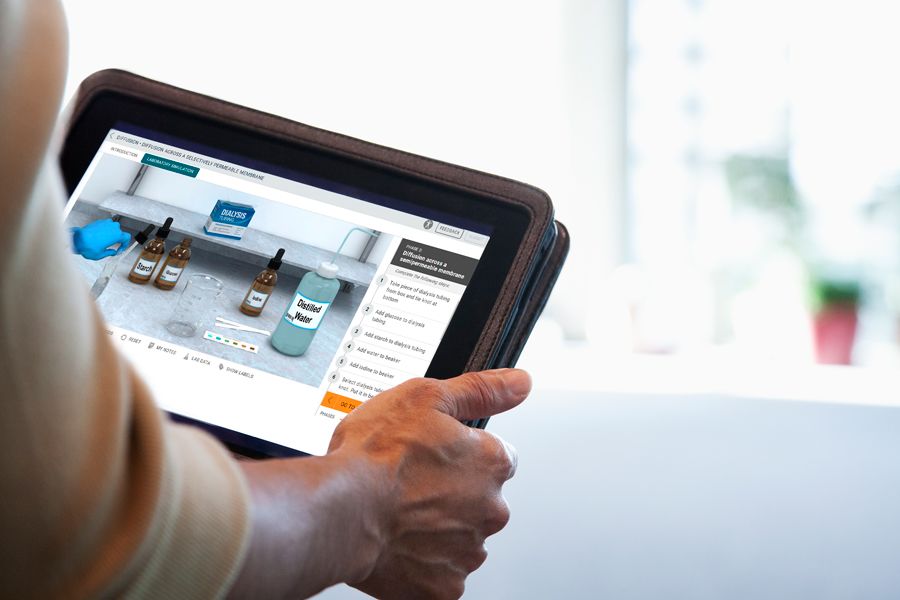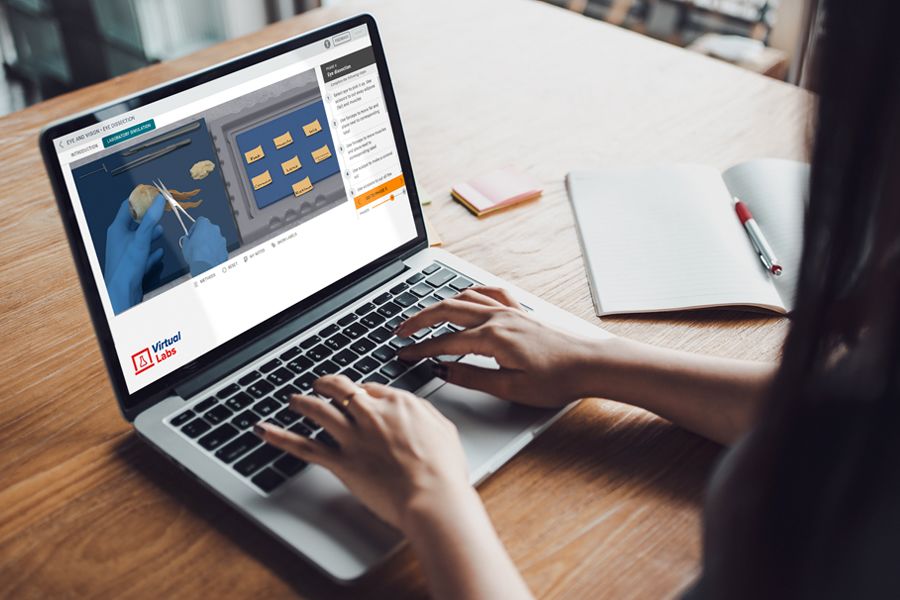This lab is
always open

McGraw Hill's Virtual Labs offers solutions to many long-standing challenges for students and instructors of lab-based courses
One of the joys of educating is seeing your efforts make a tangible difference in a student’s life. Dr. Bill Hoover recently learned how a former student used what they’d learned in his class not just to make a difference in, but to save someone else’s life.
Hoover is the coordinator of the Allied Health Sciences program at Bunker Hill Community College in Boston, Mass. The former student was working as a patient care assistant at a hospital. One day while wheeling a patient to an MRI appointment, they noticed a fibrillation pattern on the patient’s loop recorder. Knowing this meant the patient could suffer a stroke, perhaps at any moment, the student alerted the MRI room staff and the ER, and a potential crisis was averted.
“That student absolutely saved that patient’s life,” Hoover says. He’s proud that all Bunker Hill health sciences students learn not only theory but practical application, thanks in part to McGraw Hill’s Virtual Labs, which work within McGraw Hill’s Connect® courseware platform. Connect integrates with a school’s learning management system and provides a broad range of digital learning and teaching tools.
Virtual Labs is an online lab solution that provides a complement — or, if necessary, an alternative — to in-person labs. It’s available for Anatomy & Physiology, Microbiology, Majors and Non-Majors Biology, Human Biology, Environmental Science, Botany, Genetics, Medical Assisting, Phlebotomy, Nutrition, Chemistry, and Physics.
Useful for on-campus, fully remote or hybrid teaching conditions, Virtual Labs offers students and institutions the flexibility they need now and will continue to want in the future. But the benefits extend far beyond convenience. Educators who are using it find that it fills the gap between lecture and lab like no textbook could, helps instructors get the most out of limited lab time and resources, and most important, enriches the experience for students.


The adaptive programs let students work at their own pace and ensures that they’ve grasped a concept or process before moving on to the next. They were also designed with accessibility in mind. Each lab simulation is compatible with screen readers and keyboard navigation for learners whose unique needs may be difficult to meet in a traditional lab setting.
“I’ve done 10 years of digital pedagogical research, and probably the biggest feature that Virtual Labs offers to students is that it’s a safe place to make mistakes. They don’t have ‘big brother’ looking over their shoulder — meaning me — or their colleagues, so they’re not worrying about whether they’re up to speed. They can make mistakes, correct them, and learn a great deal in the process.”
“Some students definitely find confidence through the virtual realm,” says Heidi Smith, professor of Microbiology at Front Range Community College in Fort Collins, Colorado. “And so, when they come to the real lab to do it hands-on, they’re participating more than they ever would have normally. That’s one of the advantages that I didn’t predict.”
Another, Smith adds, is overcoming the group dynamics that often play out in labs.
“Traditional labs have groups of two to four students working together,” she explains. “It’s very normal to see one student sort of take over, and the other three just kind of follow along, never really having any idea what they’re doing. Or none of the students want to take over. Either way, students are missing out.”
“With Virtual Labs, you create independent learners,” agrees Melissa Gutierrez, an instructor and lab coordinator at the University of Southern Mississippi. “And it reduces the problems you can have in the real lab.” Students may or may not read and understand instructions, she explains, but she can require them to complete a simulation online before coming to the lab, and they arrive better prepared.
Richard Pirkle, a senior instructor of Anatomy and Physiology at Tennessee Tech University, introduced Virtual Labs in his classes last year — hastily, as the pandemic forced his campus to close — and admits he was surprised by the overwhelmingly positive feedback from students.
“The students really enjoyed it; they responded better than I thought they would,” he says. “I was concerned they were going to find it sort of cheesy, but they’ve said it’s neat. They like seeing how things work, or would work, in a lab. And it lowers the stress level for them. A lot of times with assessments, their stress level is so high, they’re not learning.”
He also appreciates that it saves his department and his students a lot of money.
“Since it’s bundled with the digital textbook, it’s a significant savings,” he explains. “The students buy a single license for the year, and that covers their lecture, lab, and everything they need. And they’re still getting the same concepts, so it’s better for them and better for the department.”
The McGraw Hill CARES Program offers special pricing on any course materials purchased in quantity with CARES Act HEER Funding or American Rescue Plan for the institution, department, or class and is provided to students at no charge. That’s how College of the Sequoias (COS) in Visalia, California, was able to adopt Virtual Labs last year, when the pandemic forced the campus to close.
But COS does not consider the platform a stopgap, says Francisco Banuelos, Dean of Science, Mathematics and Engineering.
“I’m sure you’re aware, there’s always resistance to offering any science course online because of the lab experience,” Banuelos says. “But our Biology faculty feels very, very comfortable keeping our General Biology courses online, because they're happy with the product. Most of our faculty have Ph.D.’s, some come from very respectful universities like Stanford, so for them to endorse the product, that’s significant. I wouldn’t have imagined that they ever would endorse anything online, to be honest with you.”
“And for me, it reduces the scheduling headaches,” he adds. COS is adding a new Animal Biology class next semester, because moving General Biology classes online freed up facilities.


It’s not just at COS — administrators and instructors at many institutions have found that Virtual Labs makes their jobs easier and helps them be more effective educators. On the back end, Virtual Labs provides a wealth of data to help instructors see where individual students, or whole classes, are struggling. Instructors then can deploy additional resources within the program or focus their lectures on those areas.
“It serves as a great pre-lab,” says Hoover. “They come in with working knowledge, so you’re not spending hours remediating them back to definitions.” Smith estimates that she saved 15 to 25 minutes per lab session by skipping live demonstrations “that half of them couldn’t see anyway.”
“I’ve used other simulations that are available,” says Gutierrez, “and they were either too complex for my students, or the opposite, too ‘kiddie’ and not user-friendly. Virtual Labs’ usability, level of concepts and objectives, and real-world application surpasses other products that are on the market.”
“Years ago, I might have said that nothing could compare to being in the wet lab,” says Smith. “I’m a science person, and we love our labs. And that’s still my preference. But now I see the advantages of simulations. Does it really matter if they touch the tool with their hand? Or does it matter more that they understand why they’re using that tool? I feel comfortable that they’re getting the same level of learning that they would if they came to campus, and I’m glad we can offer them that option. This isn’t just a band-aid to get through the pandemic. It’s actually a pretty amazing solution to some things that we’ve dealt with in the lab for a long time.”
This content was paid for and created by McGraw Hill. The editorial staff of The Chronicle had no role in its preparation. Find out more about paid content.



